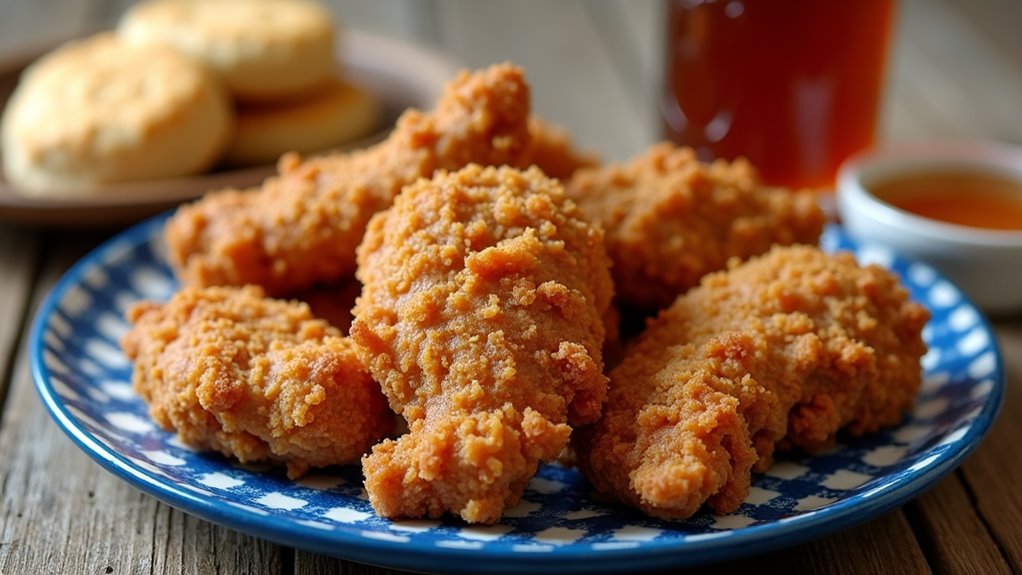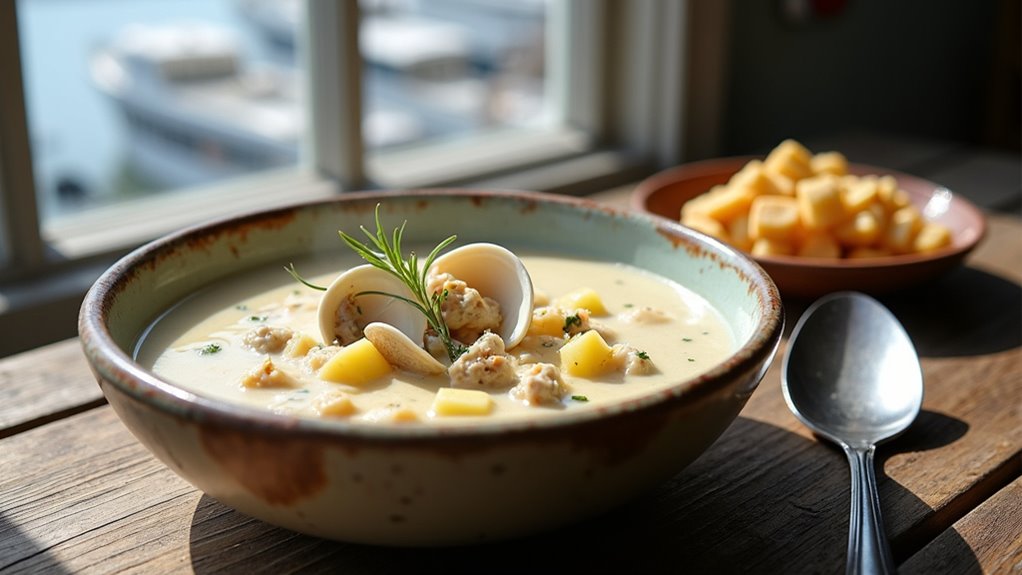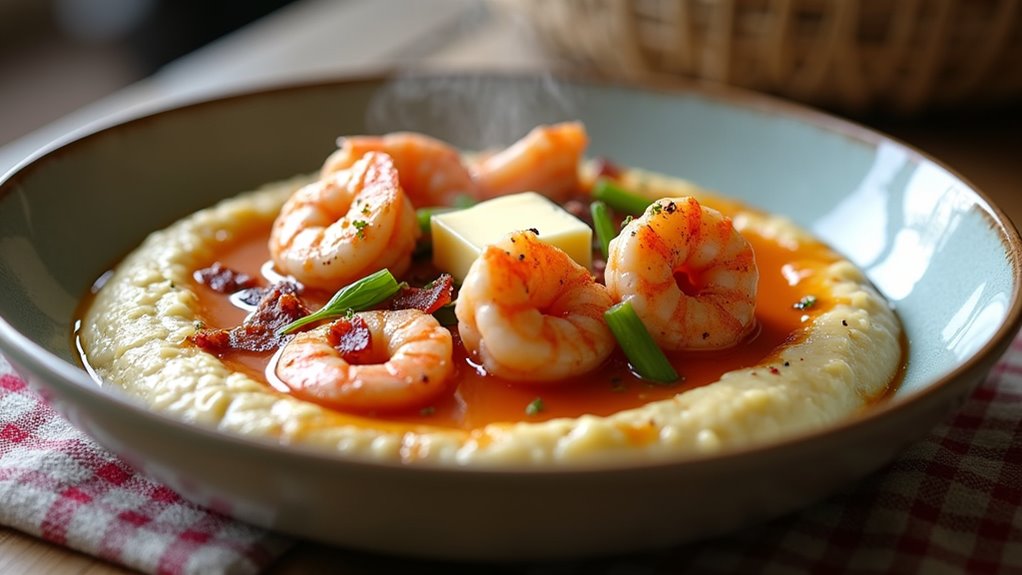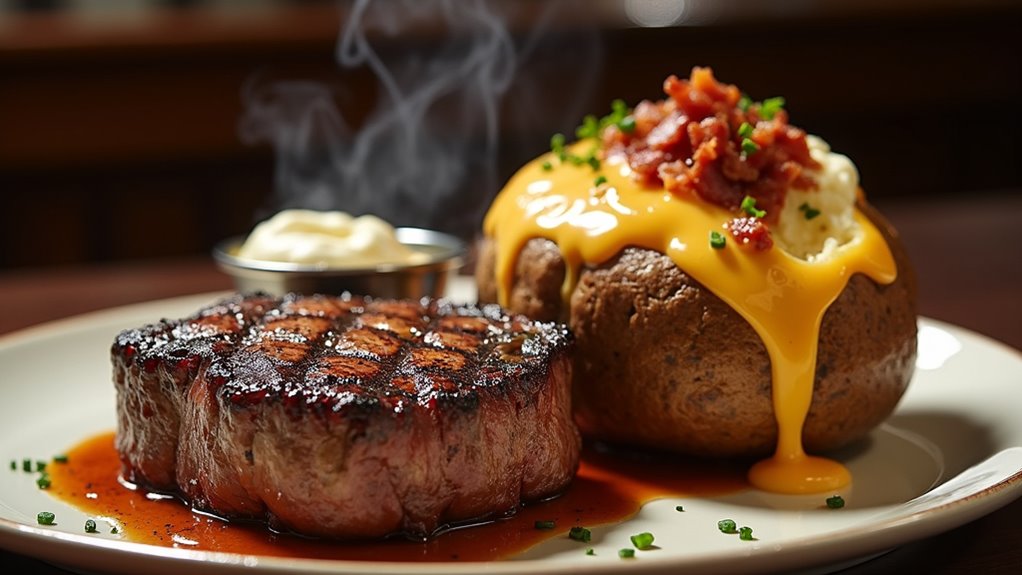Physical Address
304 North Cardinal St.
Dorchester Center, MA 02124
Physical Address
304 North Cardinal St.
Dorchester Center, MA 02124

Curious travelers can savor America's diverse culinary landscape through these 9 iconic dishes that redefine traditional expectations.
When you think of American cuisine, you’ll find it’s far more diverse than its stereotypical fast-food reputation suggests. The United States offers a opulent tapestry of flavors shaped by centuries of immigration, regional ingredients, and cultural fusion. From Southern comfort foods to New England seafood specialties, America’s food scene reflects its history and geography. Ready to discover the must-try dishes that define true American food culture? These nine iconic meals will take you on a coast-to-coast culinary journey worth experiencing firsthand.
When exploring American food culture, the hamburger stands as perhaps the most iconic culinary symbol of the nation’s identity. Originating in the 19th century through German immigrants who brought Hamburg-style beef to America, the burger has evolved into countless regional variations.
You’ll find everything from classic cheeseburgers—invented by Lionel Sternberger—to tiny sliders popularized by White Castle.
For the adventurous eater, gourmet versions featuring truffles and foie gras offer upscale alternatives, while health-conscious travelers can enjoy innovative plant-based options.
Burgers aren’t just food in America—they’re cultural touchstones that bring people together at backyard barbecues and baseball games. The dish’s widespread popularity soared during the Golden Age of Beef in the 1880s when increased livestock farming and improved transportation made beef more affordable and accessible nationwide.
Visitors to colorful cities like New Orleans can find unique regional burger interpretations that incorporate local flavors and spices.
Whether from a fast-food chain, food truck, or high-end restaurant, experiencing an American burger connects you to an essential piece of the country’s culinary heritage.
Few dishes embody American comfort food as perfectly as macaroni and cheese, a creamy concoction that has evolved from European roots into a national treasure. Though Thomas Jefferson introduced it to America, enslaved chefs like James Hemings truly popularized this beloved staple.
You’ll find mac and cheese holds special significance in African American culture, where it’s traditionally served at celebrations and holidays. In the Antebellum South, it was considered a weekend dish for special occasions. Kraft revolutionized access to this dish during the Great Depression with their boxed version, selling an impressive 8 million boxes in its first year.
Today’s versions range from simple stovetop preparations to gourmet creations featuring artisanal cheeses and creative toppings. Notably, many senior travelers seek out regional mac and cheese variations when visiting different states. Whether you prefer yours baked with a crispy breadcrumb crust or creamy with a blend of cheeses, this versatile comfort food continues to adapt while remaining quintessentially American.

How did a humble dish become one of America’s most iconic culinary exports? The history reveals a fusion of Scottish frying techniques and West African seasoning methods, perfected by African American cooks in the post-Civil War South.
You’ll find the magic lies in the details: bone-in pieces double-coated in seasoned flour and buttermilk, then fried to golden perfection in cast-iron skillets. Regional variations abound—from fiery Nashville Hot to gravy-smothered Texas style. For those planning culinary travel, exploring these regional styles offers a safer experience than many other food adventures.
While KFC and Popeyes have globalized this Southern staple, the dish remains deeply tied to cultural identity. It’s both a Sunday dinner centerpiece and a symbol of cross-cultural exchange. Historically, fried chicken was prepared mainly for special occasions due to the time-intensive process of plucking, cutting, and batch frying.
The technique has inspired international adaptations like Korean yangnyeom and Japanese karaage, cementing fried chicken’s place in global cuisine.
Where would American food culture be without the smoky, tender delight of barbecued ribs? This culinary staple represents a fusion of Indigenous, Caribbean, and African techniques that evolved into distinctly American regional styles.
You’ll find incredible variety across the country: St. Louis-style with perfectly trimmed bones, Memphis ribs with sweet tangy sauces, Kansas City’s thick tomato-based glazes, Texas’ dry-rubbed approach, and the Carolinas’ vinegar and mustard traditions. For travelers on a budget, many affordable destinations in Florida offer authentic BBQ experiences that won’t break the bank.
Despite common belief, BBQ ribs aren’t an antebellum creation but a 20th-century innovation that flourished with refrigeration. These affordable cuts were once considered waste or by-products of industrial meat packing before becoming celebrated barbecue items. What makes them special is the slow-cooking method over low heat, often using different woods to impart unique flavors.
Whether at community gatherings or restaurants, these fall-off-the-bone delicacies remain central to America’s food identity.

While many seafood dishes grace America’s culinary landscape, New England clam chowder stands as a quintessential coastal treasure with roots dating back to the late 17th century. This creamy soup evolved from European influences and indigenous cooking traditions, creating a perfect marriage of Old and New World flavors.
You’ll find its classic preparation includes tender clams, potatoes, salt pork, and onions in a sumptuous milk or cream base. Don’t confuse it with Manhattan’s tomato-based version or Rhode Island’s clear broth variation—each region fiercely defends its style. The rivalry between these regional styles sparked the Great Clam Chowder War of 1939, when a Maine representative attempted to outlaw tomatoes in chowder.
When you’re in New England, you’ll see locals enjoying this comfort food with saltine crackers, especially on chilly days. The dish represents America’s ability to transform simple ingredients into something extraordinary that’s worth traveling for. Many travelers who visit Puerto Rico often comment on the stark contrast between New England’s rich, creamy chowders and the island’s vibrant seafood preparations.
When you think of iconic American breakfasts, few dishes rival the simple yet sublime stack of fluffy pancakes drizzled with pure maple syrup. This beloved morning staple evolved from Dutch settlers’ recipes in the 1700s, later transformed by the introduction of leavening agents that created today’s characteristically thick, airy texture.
You’ll find these golden discs at the heart of family gatherings and diners across America, where they’re often topped with butter, fresh fruits, or whipped cream. The perfect pancake requires a well-heated griddle and the skilled flip that creates that distinctive rise.
While traditional recipes remain popular, you’ll now encounter creative variations incorporating everything from chocolate chips to matcha powder, with gluten-free options available for those with dietary restrictions. This breakfast classic continues to adapt while maintaining its place in America’s culinary heart. The tradition of enjoying pancakes dates back millennia, with archaeological evidence suggesting that humans have been making flat cakes on hot surfaces for at least 30,000 years. For those seeking tropical breakfast alternatives, both island paradises like Hawaii and Fiji offer their own unique morning culinary traditions.

Moving from sweet morning treats to savory Southern comfort, shrimp and grits stands as one of America’s most soulful culinary creations. This Lowcountry classic emerged from enslaved African cooks who blended West African corn-seafood traditions with Native American grits preparation techniques.
You’ll find the dish centers on creamy stone-ground grits topped with fresh shrimp, often complemented by garlic, onions, and spices. While Charleston versions typically feature tomato-based gravy, Cajun preparations incorporate smoked sausage. The dish’s culinary roots can be traced back to Mozambique cuisine, where similar combinations of corn and shellfish predated American versions.
Once a humble breakfast staple, shrimp and grits evolved into an upscale dinner entrée after Chef Bill Neal popularized his creamy version in the 1980s.
Today’s chefs honor the dish’s African roots while experimenting with modern twists like truffle oil or blue-cheese infusions. Unlike Michigan’s diverse snake species, which thrive in specific ecological niches, shrimp and grits has successfully adapted to various regional interpretations across America. Don’t miss this perfect example of how America’s food history blends cultural influences.
Few American foods have exploded onto the culinary scene with as much cultural impact as Buffalo chicken wings. Born in 1964 at Buffalo’s Anchor Bar when Teressa Bellissimo transformed leftover wings with cayenne-vinegar sauce, they’ve become synonymous with football culture and sports gatherings.
You’ll find these deep-fried, unbreaded wings traditionally served with cooling celery sticks and bleu cheese dressing—a perfect combination that balances heat with relief. While the original cayenne sauce remains popular, modern variations include honey BBQ, garlic-parmesan, and global fusion flavors. The recipe was a spontaneous creation based on a kitchen surplus that Teresa Bellissimo cleverly repurposed. Just as hikers conquer Camelback Mountain for its iconic status, foodies seek out authentic Buffalo wings as a culinary achievement.
During Super Bowl weekend alone, Americans consume approximately 1.4 billion wings. Whether you’re enjoying them at a sports bar, restaurant chain like Buffalo Wild Wings, or making them at home, these spicy, shareable treats represent communal eating at its most deliciously American.

The quintessential American dinner plate often features the unrivaled combination of perfectly cooked steak and a generously loaded baked potato. You’ll find premium cuts like ribeye or NY strip seasoned simply with kosher salt and pepper, then reverse-seared or pan-seared to perfection.
The ideal accompaniment is a russet potato baked until its oil-rubbed skin turns crispy while the interior remains fluffy. After resting your steak (crucial for retaining juices), slice it against the grain and serve alongside your potato loaded with toppings of your choice—shredded cheddar, sour cream, bacon bits, and scallions are classics. For a spicy twist with Mexican influence, try the carne asada version loaded with marinated steak, melted cheese, and fresh pico de gallo.
For extra indulgence, drizzle with a parmesan cream sauce or compound butter. This hearty meal embodies American comfort food culture, whether enjoyed at home or at a steakhouse.
You’ve glimpsed America’s culinary soul through these nine iconic dishes, but countless regional treasures await your discovery. Will you venture to Maine for a perfect lobster roll? Perhaps New Orleans’ jambalaya calls your name? Or maybe Chicago’s deep-dish pizza tempts your palate? The journey through America’s food landscape doesn’t end here—it’s just getting started. What will you taste next?